 |
: January 2007 |
||||||||
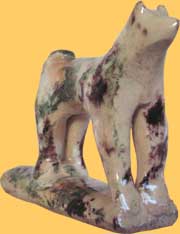 |
Discovery context: This new whistle of the month came from Great-Britain. It shows how it's difficult to attribute a whistle to a potter center. General description: This is a dog shaped whistle. The dog is crudely modeled standing on a flat rectangular base. It is 6,5 cm length, 5,4 cm high and 2,2 cm width. Decoration: The clay is light beige coloured. The body of the dog and the top of the base are white glazed with greenn reddish and brown spots. The base bottom is unglazed.
|
 |
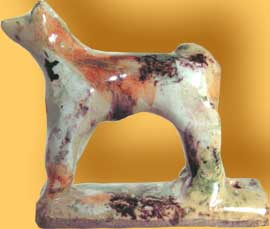
 |
||||||
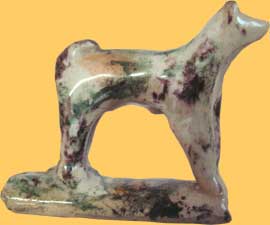 |
The study of the object: Typology: It is a tubular whistle of the Nixdorff's type B5. The whistle is in the flat base. The mouth piece is on the back and the window is opened in the top of the base at the back of the dog. Analysis:
To attribute this whistle is a problem. No reference book shows this kind of whistle inspite of an important production. Several similar whistles are in private collections. |
||||||||
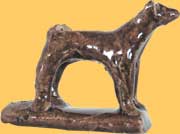 Brown glaze 4,7 X 6,6 X 2,3 Private col. |
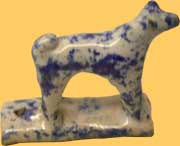 Blue spongeware Private col. |
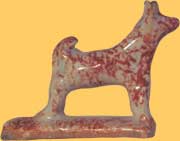 Pink spongeware 5,4 X 7 X 2,2 Private col. |
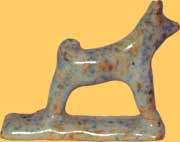 Blue and orange spongeware 5,2 X 6,9 X 2,4 Private col. |
||||||
|
Similar models: Many different glazes are used on these whistles: blue, pink, orange patches, brown or blue spots, etc. The dog is sometimes modeled in a variant shape. All the whistles have similar dimensions and were probably made in the same workshop. They all come from Great Britain what can mean an English production. The spotted glazes can be linked to the Prattware Staffordshire figurines. Usually, the collectors think that they are Staffordshire whistles. |
|||||||||
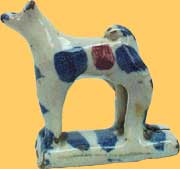 Brown and blue spots Private col. |
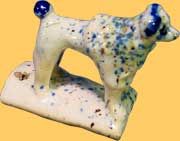 Blue and yellow spongeware Private col. |
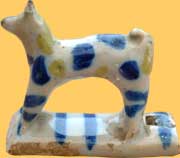 Yellow and blue spots Private col. |
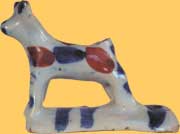 Brown and blue spots 5,1 X 7 X 2,5 Private col. |
||||||
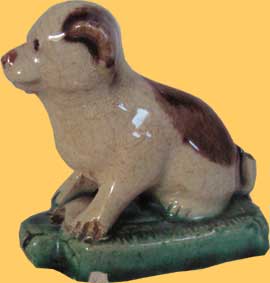 Staffordshire dog Creamware H: 5 X L: 5,4 X w: 2,7 Private col. |
English whistles in a similar shape: Effectively, a similar kind of whistle was made in Staffordshire. They are also small whistles with the whistle in a flat base. But the end of their socle narrows to the whistle mouth at the difference of the whistle of the month. The glazes are also different. The animals are more detailed and usually, they are lying on the socle. Their glaze can be compared with the small bird whistles made in Staffordshire or with the "creamware" pottery. They were probably made in this place where more than 1500 potters have worked since 1700. If the whistle of the month wasn't made in England, is there other European countries making a similar type of figural whistles? |
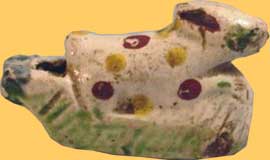
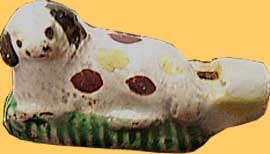 Staffordshire whistles Private col. |
|||||||
| Spain: During a great exhibition about whistles, it is a coincidence that we can find them in Spain. In "Tônender Ton", Mrs Nixdorff only shows two whistles of this kind found in Pamplona in the Spanish Basque Country. They are small figural whistles (a 'head' and a 'dog?') at the front of a flat socle. The shape of the flat base is a scalloped rounded rectangular. They were found in 1935. They were used for processions in the Tarragonna area (Catalonia). |
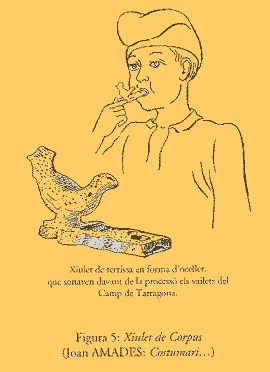 Extract of "Musica oral del Sur" Centro de documentacion de Andalucia |
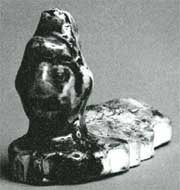
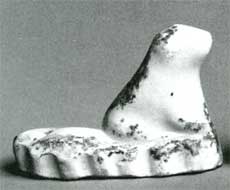 Dog? and head circa 1935 L: 5,2cm Found in Pampelona 1935 Col Museum für Völkerkunde Berlin Pictures from "Tonender Ton" |
|||||||
| There were other shapes. One was a Virgin and Child whistle what confirms their use during religious feasts. A cat shaped whistle has a pink spotted glaze reminding some 'English' whistles glaze. Like those ones, all those Spanish whistles are unglazed under the base. If they have many common caracteristics, their scalloped bases and the figurines are very different to the dogshaped whistles. |
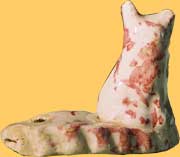 Cat? H: 4cm L: 5,2cm W: 2,8cm Private col. |
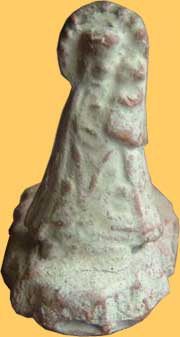 The Virgin and Child Private col. |
|||||||
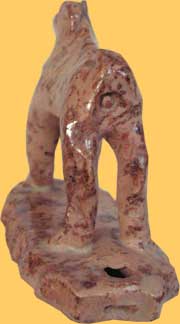 Dog with long ears bending to the back H: 6,3cm L: 8,3cm W: 3,5cm Private col. |
The missing link: A dog shaped whistle with long ears has caracteristics of both series. It also came from Great Britain. Its base is a Spanish shaped one but the dog is modeled like the whistle of the month. It is taller than the English dog whistles but a whistle of the 'English' series ( with a rectangular base and similar dimensions) makes the link. Both whistles have exactly the same shape and were probably made by the same potter. |
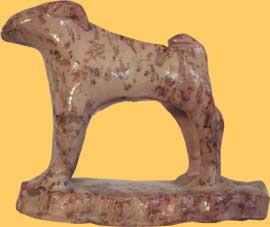 Dog on a Spanish base
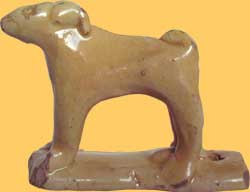 Dog on an 'English' base H: 5,1cm L: 6,8cm W: 2,2cm Private col. |
|||||||
| In conclusion: Very often, the place where a whistle was found isn't enough to know where it was made. The whistle of the month is part of a large series found in Great Britain when it's more logical that it was made in Spain. The precise place of production is unknown but it was probably in Catalunia where the processions with those whistles took place. How those whistles went to England?
Both possibility of importation give a same date: late 19th early 20th. The dog shaped whistles were probably made during this period. In most European country, a similar process exists:
|
|||||||||